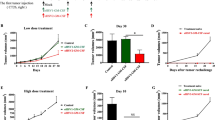Abstract
To improve the safety profile and specificity in cancer gene therapy applications, а set of singleplasmid vectors for expression of suicide thymidine kinase gene of the herpes simplex virus (HSVtk) and mouse OX40L gene (m0X40L) involved in regulation of immune response was constructed. Therapeutic transgene expression was directed by a strong constitutive promoter of human cytomegalovirus (CMV), while translation occurred on an RNA template due to an encephalomyocarditis virus internal ribosome entry site (construct CMV-HSVtk-IRES-mOX40L) or 2A-peptide of Porcine Teschovirus-1 (construct CMV-HSVtk-2AmOX40L) inserted between them. The constructs obtained were functionally validated by transient transfection of C26 cells (mouse colon carcinoma). Both bicystronic vectors demonstrated strong cytotoxic activity and produced cytotoxic protein HSVtk at the similar level. To analyze efficiency of mOX40L expression, C26 transfected cells were immunofluorescence-labelled with anti-OX40L-antibodies conjugated with phycoerythrin following flow cytometric analysis. Production of mOX40L was higher in the case of CMV-HSVtk- 2A-mOX40L. Better performance of this expression vector was correlated with our data. Previously, we have demonstrated that a higher level of transgene expression was exhibited by cells transfected with the vector containing the 2A peptide sequence. Thus, transfection with the vector based on the 2A peptide sequence is optimal for achieving high efficiency of expression of both oncotherapeutic genes.
Similar content being viewed by others
References
Sverdlov, E.D., Genetic surgery—a right strategy to attack cancer, Curr. Gene Ther., 2011, vol. 11, no. 6, pp. 501–531.
Matthews, T. and Boehme, R., Antiviral activity and mechanism of action of ganciclovir, Rev. Infect. Dis., 1988, vol. 10, no. 3, Suppl., pp. S490–S494.
Kurozumi, K., Tamiya, T., Ono, Y., et al., Apoptosis induction with 5–fluorocytosine/cytosine deaminase gene therapy for human malignant glioma cells mediated by adenovirus, J. Neuro–Oncol., 2004, vol. 66, nos. 1–2, pp. 117–127.
Mesnil, M. and Yamasaki, H., Bystander effect in herpes simplex virus–thymidine kinase/ganciclovir cancer gene therapy: Role of gap–junctional intercellular communication, Cancer. Res., 2000, vol. 60, no. 15, pp. 3989–3999.
Collins, S.A., Buhles, A., Scallan, M.F., et al., AAV2–mediated in vivo immune gene therapy of solid tumours, Genet. Vaccines Ther., 2010, vol. 8, p. 8. doi 10.1186/1479–0556–8–8
Cerullo, V., Pesonen, S., Diaconu, I., et al., Oncolytic adenovirus coding for granulocyte macrophage colonystimulating factor induces antitumoral immunity in cancer patients, Cancer Res., 2010, vol. 70, no. 11, pp. 4297–4309.
Dranoff, G., Jaffee, E., Lazenby, A., et al., Vaccination with irradiated tumor cells engineered to secrete murine granulocyte–macrophage colony–stimulating factor stimulates potent, specific, and long–lasting anti–tumor immunity, Proc. Natl. Acad. Sci. U. S. A., 1993, vol. 90, no. 8, pp. 3539–3543.
Shi, Y., Liu, C.H., Roberts, A.I., et al., Granulocytemacrophage colony–stimulating factor (GM–CSF) and T–cell responses: What we do and don’t know, Cell Res., 2006, vol. 16, no. 2, pp. 126–133.
Alekseenko, I.V., Kopantzev, E.P., Vinogradova, T.V., and Sverdlov, E.D., Bicistronic vector for combined expression of the HSVtk killer gene and cytokine GMCSF gene in cancer cells, Dokl. Biochem. Biophys., 2011, vol. 439, pp. 174–177.
Alekseenko, I.V., Snezhkov, E.V., Chernov, I.P., et al., Therapeutic properties of a vector carrying the HSV thymidine kinase and GM–CSF genes and delivered as a complex with a cationic copolymer, J. Transl. Med., 2015, vol. 4, no. 13, p. 78.
Bordon, Y., Immunotherapy: Checkpoint parley, Nat. Rev. Cancer, 2015, vol. 15, no. 1, p. 3.
Croft, V., Control of immunity by the TNFR–related molecule OX40 (CD134), Annu. Rev. Immunol., 2010, vol. 28, pp. 57–78.
Ghattas, I.R., Sanes, J.R., and Majors, J.E., The encephalomyocarditis virus internal ribosome entry site allows efficient coexpression of two genes from a recombinant provirus in cultured cells and in embryos, Mol. Cell. Biol., 1991, vol. 11, no. 12, pp. 5848–5859.
de Felipe, P., Luke, G.A., Hughes, L.E., et al., E unum pluribus: Multiple proteins from a self–processing polyprotein, Trends Biotechnol., 2006, vol. 24, no. 2, pp. 68–75.
Kuzmich, A.I., Vvedenskii, A.V., Kopantzev, E.P., and Vinogradova, T.V., Quantitative comparison of gene co–expression in a bicistronic vector harboring IRES or coding sequence of porcine teschovirus 2A peptide, Russ. J. Bioorg. Chem., 2013, vol. 39, no. 4, pp. 406–416.
Author information
Authors and Affiliations
Corresponding author
Additional information
Original Russian Text © I.V. Alekseenko, M.B. Kostina, E.O. Serebrovskaya, V.K. Potapov, E.D. Sverdlov, 2018, published in Molekulyarnaya Genetika, Mikrobiologiya i Virusologiya, 2018, No. 1, pp. 14–18.
About this article
Cite this article
Alekseenko, I.V., Kostina, M.B., Serebrovskaya, E.O. et al. Comparative Analysis of Gene Therapy Systems Expressing Two Oncotherapeutic Genes under Control of a Single Promotor. Mol. Genet. Microbiol. Virol. 33, 15–20 (2018). https://doi.org/10.3103/S0891416818010020
Received:
Accepted:
Published:
Issue Date:
DOI: https://doi.org/10.3103/S0891416818010020




